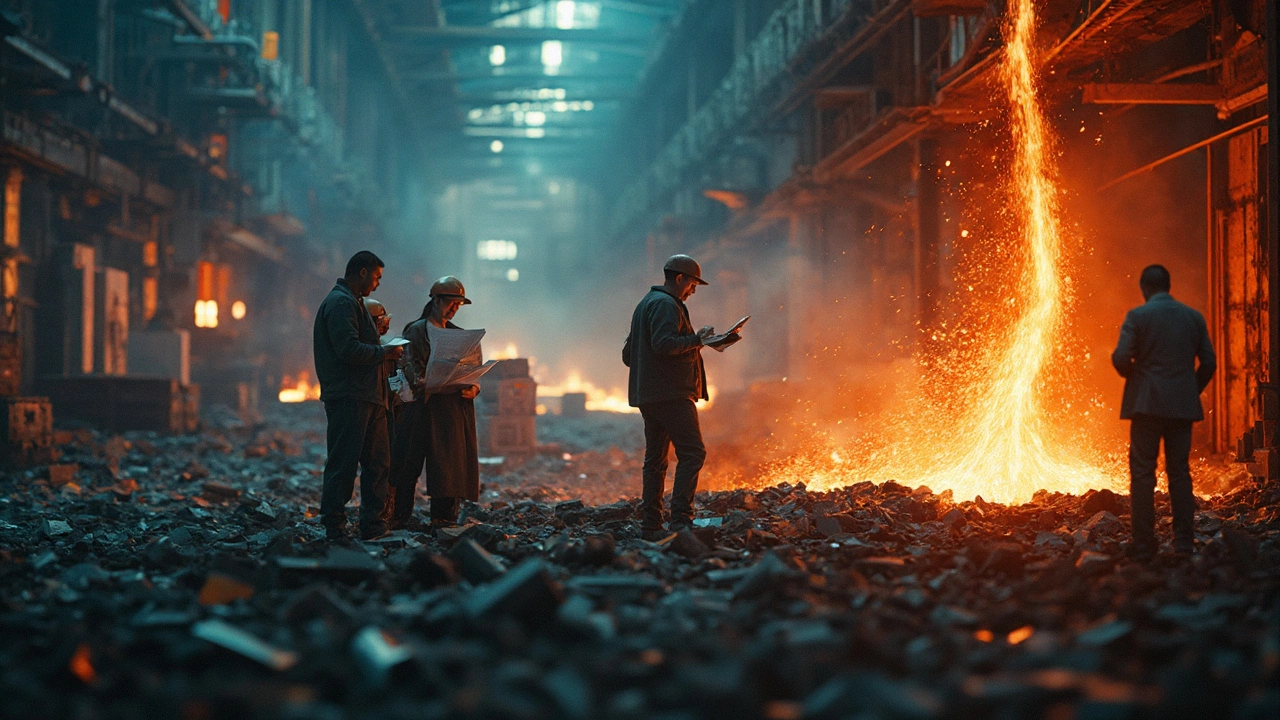Getting rich in the steel industry isn’t just some old industrial legend—it’s real, and it’s happened more times than most people think. Ever wondered who was the first to stash their millions or how modern steel bosses make it happen? Spoiler: it’s not just about owning giant factories or being at the right place, right time.
The steel game rewards people who aren’t afraid to get their hands dirty and take a gamble. Take Andrew Carnegie, for example. The guy started with almost nothing, hustled through countless jobs, and ended up running the biggest steel operation of his day. Fast forward a century, and you’ll find leaders doing things differently, but still raking in the millions—just with sharper tech and smarter deals.
But breaking into the league of steel millionaires today? It’s honestly less about being born rich and more about guts, timing, and really knowing your numbers. If you think it’s all about running massive plants, think again—some of the most successful folks started small, found a niche, or totally flipped the way people buy and sell steel. There’s no magic formula, but understanding how these guys did it can actually open your eyes to some very real opportunities.
- The First Millionaires in Steel—Who Started It All?
- Modern Steel Tycoons and Their Secrets
- What Gave These Steel Giants Their Edge?
- Surprising Facts: Risks That Turned into Fortunes
- Tips: How to Get Your Piece of the Steel Pie Today
The First Millionaires in Steel—Who Started It All?
If you ask anybody about early steel millionaires, one name will always pop up: Andrew Carnegie. This guy basically wrote the playbook for rags-to-riches in the steel industry. Carnegie grew up poor—he worked as a bobbin boy in a cotton factory at just 13. He moved through jobs, hustled nonstop, and later started investing in iron and steel. By the time he was in his forties, he controlled the biggest steel company in the U.S. That’s not just old news—Carnegie’s strategies on cost-cutting, reinvesting profits, and paying close attention to tech changes still show up in boardrooms today.
But Carnegie wasn’t alone. Charles Schwab (not the banker) was Carnegie’s right-hand man before launching his own empire, Bethlehem Steel. Schwab pushed cutting-edge processes like the H-beam, which changed how skyscrapers were built. Bethlehem Steel turned into a massive operation, making Schwab a millionaire many times over long before he hit retirement age.
These early steel tycoons didn’t just get lucky. They bet on ideas, scaled up fast, and grabbed every efficiency they could. For example, Carnegie’s Homestead Works reduced costs with the Bessemer process and by recycling scrap—back then, that was high-tech. And while a lot of stories focus on big U.S. names, families in Europe (like Alfred Krupp in Germany) also figured out how to turn steel into a fortune—some are still in the business today.
What’s the takeaway for someone looking at the industry now? The first millionaires in steel didn’t always start with money or connections. They spotted tech that could change the game, made tough calls before others dared, and never stopped looking for the next advantage. Even in a tough, traditional business, mindset made the difference.
Modern Steel Tycoons and Their Secrets
The steel industry isn’t all smokestacks and gritty mills anymore. Today’s biggest players are part tech-wizard, part operator, and part dealmaker. Just look at Lakshmi Mittal, who went from running a simple family business in India to controlling one of the world’s biggest steel empires, ArcelorMittal. He didn’t just stick to running plants—he bought out rivals, fixed failing operations, and always looked globally for the next big opportunity. His real win? He understood supply chains better than anyone else and invested heavily in emerging markets when everyone else hesitated.
In China, another heavyweight is Zhang Zhixiang, also called the “Steel King.” He took charge of Shougang Group and grew its reach way beyond what people thought possible. Zhang knew that adapting fast—especially to tech changes and market shifts—meant survival. When most steel firms struggled, his company found ways to use automation and better logistics to keep costs down and profits up.
Here’s a quick snapshot of the world’s top steel manufacturers by production (2024):
| Company | Country | 2024 Output (Million Tonnes) |
|---|---|---|
| ArcelorMittal | Luxembourg/Global | 68 |
| China Baowu Steel Group | China | 132 |
| Nippon Steel | Japan | 44 |
| Shougang Group | China | 35 |
So what secrets do these modern tycoons share? Sure, they have cash and connections, but they’re obsessed with efficiency. They invest in automation, snap up failing companies if there’s hidden value, and move fast when new markets open up. That’s how they survived and got richer even when global demand took a nosedive or when new environmental rules hit hard.
Another thing—they never sit still. Even small tweaks in transportation routes or switching to recycled scrap can save millions. For anyone hoping to follow in their footsteps, the message is clear: It’s not about being the biggest name. It’s about staying sharp, playing the long game, and never getting comfortable.

What Gave These Steel Giants Their Edge?
So what took these folks from the average crowd right into the millionaire spotlight? It's not as mysterious as it might seem. Their secret sauce usually comes down to using technology faster, cutting costs better, and never being afraid to make big, bold moves—sometimes when everyone else thought they were nuts.
If you look at Andrew Carnegie, he’s the classic blueprint. Back in the late 1800s, while others stuck to old-school methods, Carnegie jumped on the Bessemer process—a cheaper, faster way to turn iron into steel. This wasn’t just smart; it slashed expenses and let him sell steel for less than his competition. He also built a network, locking in railroads and you-name-it deals that kept him in business even when prices dropped. The numbers don’t lie:
| Millionaire | Key Move | Estimated Wealth (in today’s dollars) |
|---|---|---|
| Andrew Carnegie | Bessemer process adoption | $372 billion |
| Lakshmi Mittal | Mergers & global deals | $17 billion |
| John D. Rockefeller (U.S. Steel share) | Strategic investments | $340 billion |
Lakshmi Mittal is another modern example. He saw that buying up smaller, struggling factories around the world could add up to a global mega-business. Instead of building new plants, he made deals—sometimes in unlikely places—rolling a little risk into big profits. That grounded him as one of the richest people in the steel industry.
Here’s what usually set these guys apart:
- They grabbed new tech before everyone else did. Whether it was the Bessemer process or modern automation, they weren’t slow to change.
- The top dogs knew manufacturing wasn’t a one-man show—they locked down suppliers and buyers early so they’d never be at someone else’s mercy.
- Risk? They didn’t run from it. Instead, they made smart bets after crunching hard numbers and knowing exactly what they stood to lose—or gain.
Don’t get it twisted: these moves didn’t just make them comfortable—they made them super rich. If there’s one thing that ties these steel millionaires together, it’s the way they jumped on opportunities while others hesitated or held back.
Surprising Facts: Risks That Turned into Fortunes
Most people assume making a fortune in the steel industry is all about sticking to the basics: keep the furnaces hot, keep the workers busy, and the money will flow. But the real game-changers took chances that seemed wild at the time. For example, Andrew Carnegie actually sold his steel company to J.P. Morgan for $480 million in 1901—a shocking number back then. Some thought Carnegie was cashing out too early, but that payout made him the richest man in America.
Flash-forward a few decades. Lakshmi Mittal, born in a small Indian village, made his first big move by buying up rundown mills nobody else wanted. He took over sick companies in places like Trinidad and Kazakhstan, then turned them around and built the global steel empire ArcelorMittal. Most investors thought he was off his rocker, buying dying plants in risky countries. Turns out, jumping on what everyone else rejected was the fast-track to billions.
Here’s something else—Nucor, now one of the top steel producers in the U.S., was on the verge of collapse in the 1960s. Instead of folding, they switched to a totally new method called mini-mills, using scrap instead of iron ore. Traditionalists sneered, but that move pretty much saved the company and turned it into a powerhouse.
So what clicks here? The biggest fortunes in steel didn’t go to people who played safe. They went to people who saw opportunity where everyone else saw risk. And they had the guts to bet big when everybody else was running for the exit.
- Carnegie’s mega-sale proved that selling at the right time can beat holding forever.
- Mittal’s out-of-the-box buys showed that struggling plants aren’t always lost causes.
- Nucor’s gamble on mini-mills means thinking small sometimes beats thinking big.
If you want to take notes from the steel millionaires, don’t just follow the crowd. Look for blind spots in the market and don’t be afraid to jump in before anyone else does.

Tips: How to Get Your Piece of the Steel Pie Today
So, you want a shot at making serious money in the steel industry? It’s not just for the old-school billionaires or folks who inherited plants. The field still has room for new players, but you’ve got to be smart and pick your moves carefully. Here are some solid tips backed by real facts.
- Steel industry profits are driven by both efficiency and connections. It’s not about having the fanciest equipment, but knowing where you can shave off costs—think better sourcing, smarter logistics, or lining up reliable buyers.
- Don’t ignore smaller market gaps. Companies making custom steel parts or recycling scrap can carve out a niche and still bank serious profits. For example, over 40% of new steel in the U.S. comes from recycled scrap.
- Build relationships with end users, like construction or automotive businesses. Direct deals have more margin than selling to a middleman. You can offer tailored solutions and lock in repeat customers.
- Stay on top of technology—automation, AI-driven inventory tools, and digital procurement platforms save time and avoid expensive mistakes. According to Deloitte’s 2023 steel outlook, companies using real-time data analytics improved their operating margin by up to 15%.
Want some inspiration straight from the industry?
"To make money in steel, you need to spot where everyone else is asleep at the wheel—then outwork them, simple as that." — John Ferriola, former CEO of Nucor Corporation
If you’re thinking about getting started, weigh the investment needed versus your payoff. Some entry points don’t cost a fortune, like trading scrap or being a broker between suppliers and buyers. Here’s a look at the average annual returns for common steel industry roles:
| Role | Start-up Cost (USD) | Potential Annual Profit (USD) |
|---|---|---|
| Scrap Steel Dealer | $10,000 | $50,000 - $200,000 |
| Small Fabrication Shop | $200,000 | $250,000 - $1M |
| Broker/Trading Agent | $5,000 | $40,000 - $150,000 |
| Full-Scale Manufacture | $10M+ | $5M+ |
The biggest gains come to people who move fast and aren’t afraid to adjust their game plan. Pay attention to supply chain issues and price swings—something as basic as negotiating fuel rates for shipments can add thousands to your bottom line every year. And don’t ignore old-school advice: talk to people on the floor, in the yard, and at the shipping dock. Sometimes the best intel isn’t in a spreadsheet, but in what people are saying.
